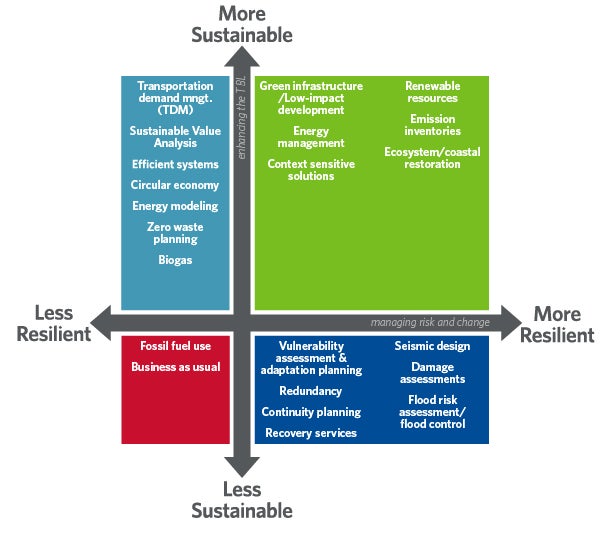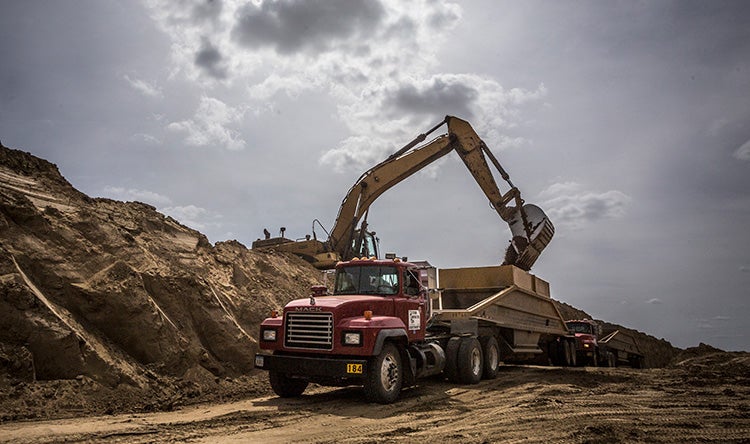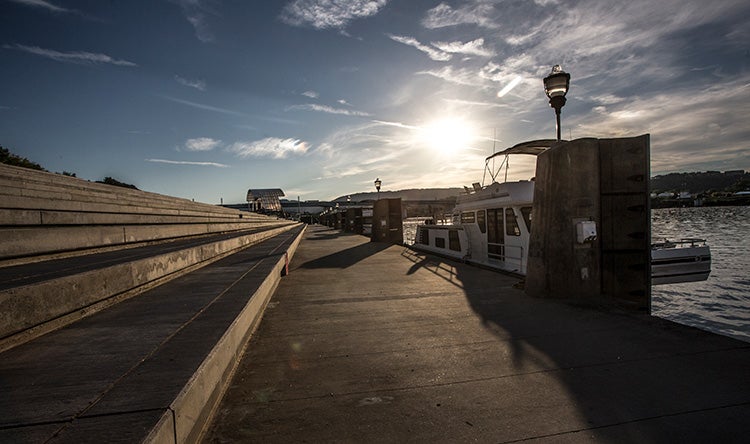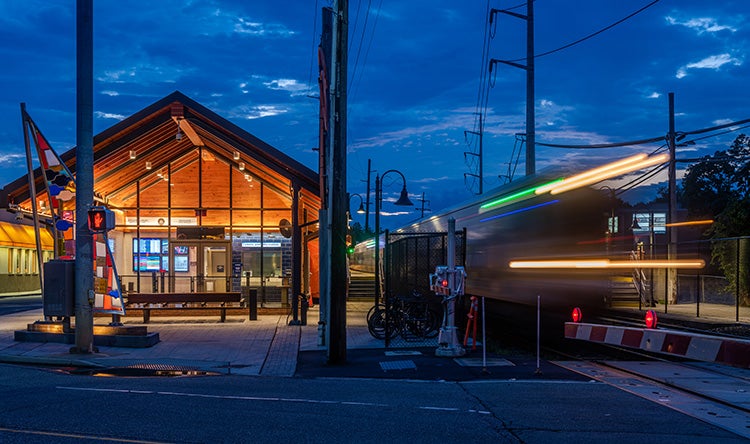
Experts Talk: The Economics of Sustainability and Resiliency with Pamela Yonkin
Experts Talk is an interview series with technical leaders from across our transportation program.
When Does It Make Financial Sense to Invest in Sustainability and Resiliency?

With stiff competition for every dollar, transportation agencies need facts and data to make the best decisions for their communities. Sustainable, resilient projects last longer, can save money in the long term and can withstand unique shocks and hazards. Resiliency and sustainability planning makes good financial sense — just ask an economist.
Economist Pamela Yonkin heads our transportation resiliency and sustainability practice, and she is an expert in helping clients use data to make decisions related to resiliency and sustainability. Yonkin, ENV SP, has decades of experience performing economic analyses of transportation projects and many of her projects have involved the issues of sustainability and resiliency.
The Economics of Sustainability and Resiliency
Q. What is the difference between sustainability and resiliency?

A. Sustainability is the practice of meeting the needs of the present without compromising the ability of future generations to meet their own needs. It is accomplished when, for example, we reduce or eliminate environmental impacts, improve quality of life for communities, and do so in a way that can be maintained economically. Resiliency is the practice of designing things to endure physical, social and economic shocks and stresses. Ideally, resilient infrastructure endures, rapidly responds and prospers, despite these unexpected impacts. The two concepts complement each other when we create dynamic, adaptive systems that will protect human health, economic security and environmental wellbeing. If you build something that’s both sustainable and resilient, it lasts longer and it bounces back more easily from shocks.
For example, if you build a sustainable transit station, you'd want something that improves the community’s quality of life. Possibly it includes active transportation elements and better lighting, which better connect the neighbourhood to transit and improve station safety. These improvements may also encourage someone to take the bus, bicycle or walk on a safe sidewalk, resulting in reduced emissions. The building could have solar panels, saving on utility costs but also reducing emissions even more. To be resilient, the station could be built outside the floodplain and resistant to local hazards. In that way it’s the whole package: damage resistant, long-lasting and improves quality of life.

Q. What does economics have to do with sustainability and resiliency?
A. Both in our personal and professional lives, we continually weigh the benefits and costs associated with different decisions. Incorporating economics into decisions related to sustainability and resiliency is a very natural extension of this. It can lead to a pretty persuasive argument for building a “greener” building or one that can stand up to natural disasters. For example, it might be more expensive in the near-term to build a project with sustainability and resiliency features, but there may be the potential to save a lot of money in the long term on utility costs and emergency repair bills due to those same features. There are also approaches for putting dollar values on things like public safety, journey quality, and cleaner air, reflecting even greater value for designs that incorporate features that support these features.
Most transit agencies, municipalities and transportation authorities also have more potential projects than they have funding, and they need ways to prioritize their investments. Decision-making with an economic basis can support this effort. We all know it’s really important to provide a pragmatic, feasible solution rather than just identify the problems. Economics can help with the process of reasonable decision-making.

Q. Why should community and transportation leaders invest limited dollars in resiliency and sustainability?
A. In short, it can reduce project costs long-term. Failing to consider sustainability and resiliency reflects the “penny wise, pound foolish” idiom perfectly. If we think about sustainability from a triple bottom line perspective, we consider the environmental and social elements of a project, but also whether it is economically sustainable. The whole point is designing infrastructure that uses limited funding wisely by being holistic in terms of its impact, understands the full value of the infrastructure investment over its life cycle, and ensures long term economic sustainability. It might be more expensive on the front end, but its long-term value should outweigh its short-term costs, making it more sustainable over time.
What happens when owners do not consider whether the infrastructure they build is resilient? Those owners may wind up experiencing an unexpected shock, with associated emergency repairs likely at a premium and the possibility that the “fix” is short term. If a similar event happens again, they will incur those same costs or more because the infrastructure is likely still inadequate. Considering resiliency in planning and design means mitigating the costs associated with different risks. It also means considering other factors, such as the impact of the loss of critical infrastructure or the ability for critical personnel to get to and perform their jobs. We have many tools at our disposal to work with our client programs to understand which assets are most critical or most vulnerable, the risks of an event occurring, and the potential impact, cost and other consequences, if something does happen. That gives us an understanding of when to invest in more resilient designs. Incorporating resiliency thinking into decision making is the best approach when investing limited dollars in infrastructure that is, in many cases, likely to outlive us.
Thinking about projects in this new way also forces innovation, and it can save money in the short-term as well. For example, sometimes a big expense with large infrastructure projects is disposing of materials. If you reuse materials on site, you save yourself trucking costs and that's a near-term cost that you don't have to pay. Society may be better off too because fewer truck-miles means fewer emissions and less wear and tear on public roads. But you have to think about that before you contract for a waste hauler. These types of considerations need to happen at the planning and design stage, not after you've come up with the design and are trying to construct it.

Q. What kinds of infrastructure programs need to incorporate resiliency/sustainability in the planning stages?
A. All kinds of projects! During the planning stage, trade-offs associated with different alternatives can be understood. Typical questions include: Is there an opportunity to reduce lifecycle costs? What is the true value of sustainable and resilient infrastructure alternatives and can these benefits be monetized and compared to the lifecycle costs? Are there ways to achieve other-than-mobility-related goals by choosing one alternative over another?
In addition to supporting a more holistic planning process, these assessments are the foundation for establishing sustainable and resilient design goals, such as greenhouse gas minimization, stormwater runoff quantity and energy efficiency. Where possible, resilience should be linked to sustainability so that the resilience we are trying to plan and design for actually helps us move toward a sustainable system in the future. For example, designing a barrier to protect a structure from storm surge may support resiliency efforts but is potentially expensive to maintain; in other words, it is not economically sustainable.
Sometimes the analysis shows it doesn’t make sense to invest more. For a New York port, we considered whether we should design and build a more resilient wharf today, build a more traditional wharf with the ability to be resiliency-enhanced, or altogether skip adding anything to address resiliency. Turns out, the ability to add resiliency features to the wharf at some point in the future was the most cost-effective choice. Near term, the risks of an event occurring were low enough that managing unexpected emergency repairs was more cost-effective. Longer term, however, sea level rise projections and other considerations made the probability of an unexpected event more likely and the impact more significant. We are doing a similar analysis in the Florida Keys – helping the county determine which roadways are most vulnerable, most critical, and ultimately prioritized for near-term investment.

Q. What kinds of events do sustainability and resiliency efforts help mitigate?
A. Different geographical regions have different things to deal with from a climate perspective, whether it's snowmelt or drought or flooding and scarcity. Fire, earthquakes and tornadoes can also impact infrastructure across the U.S. and the world. Cybersecurity and terrorism are some non-climate disasters that we have to consider when planning important infrastructure projects. In other words, all of us should be thinking about resilient and sustainable infrastructure.
One more reminder of the importance of proper planning is the pandemic. We should take some lessons from this experience to emphasize the importance of not just responding to a crisis but planning for it, mitigating it, and ultimately reducing its impact.
Q. How does the COVID-19 pandemic show the importance of sustainability and resiliency?
A. Immediately, it reminds us of the importance of risk management and emergency preparedness. It also reminds us of the importance of sustainable design. Over and over again, social equity has risen to the top in terms of factors that really need to be considered when planning for disaster, whether a pandemic or climate-related.
For example, transit agencies are making tough decisions right now with less revenue and new sanitation restrictions. When revenues go down because people are afraid to take the bus, the tendency can be to decrease service across the board. However, when you look at the details, that may not make a lot of sense. Some routes might be going directly from, say, a suburban location to the financial district. If many of the people on that route don’t rely on public transit as their only option, you could consider completely eliminating that service in order to maintain or even increase service in a community where there is a significant transit-dependent population. Planning a sustainable and resilient transit system means considering economic, environmental and social factors, especially your riders, their demographics, and their service needs. It also means designing a system that can be flexible and able to “bounce back” after a shock occurs.

Inspiration & Advice
Q. How did you become interested in resiliency and sustainability?
A. I have thought about this since I was a kid! Going to the dump with my dad, thinking that there must be a better way. Playing in a creek and witnessing how quickly water can erode something. Being simultaneously proud and mortified by the way my mom made things stretch to many uses, forced hand-me-downs, repurposed old furniture. Remembering my parents’ decisions about windows and lighting and house orientation when they built their house in the ’70s. And then I grew up and realized that these little things can be applied to very big concepts and scales.
Q. What advice do you have for someone just starting to work in the field?
A. Be pragmatic and persuasive but not overly opinionated. Rome was not built in a day. Oftentimes working in the sustainability realm involves meeting people on their level and explaining the concrete benefits. If you don’t reach people on their level, you lose their interest.
Look for opportunities to help, even on a small scale. Consider bringing up the topics of resiliency and sustainability in your office, perhaps via a young professional group. To the extent possible, bring this stuff up whenever you can. Don't be afraid to say things like, “You know, we didn't really talk about whether we should be using permeable pavement.”
More generally, if someone seems to have a job that you think is really cool, give them a call and see if you can learn from them. Get involved in groups, even local groups that are interested in these issues and learn about your own community. Baby steps go a long way. Lots of people doing small things related to resiliency and sustainability really can make a big difference and impact in their communities.
Each Experts Talk interview illuminates a different aspect of transportation infrastructure planning, design and delivery. Check back regularly to gain insights from specialized experts and thought leaders behind our award-winning, full service consulting practice.



